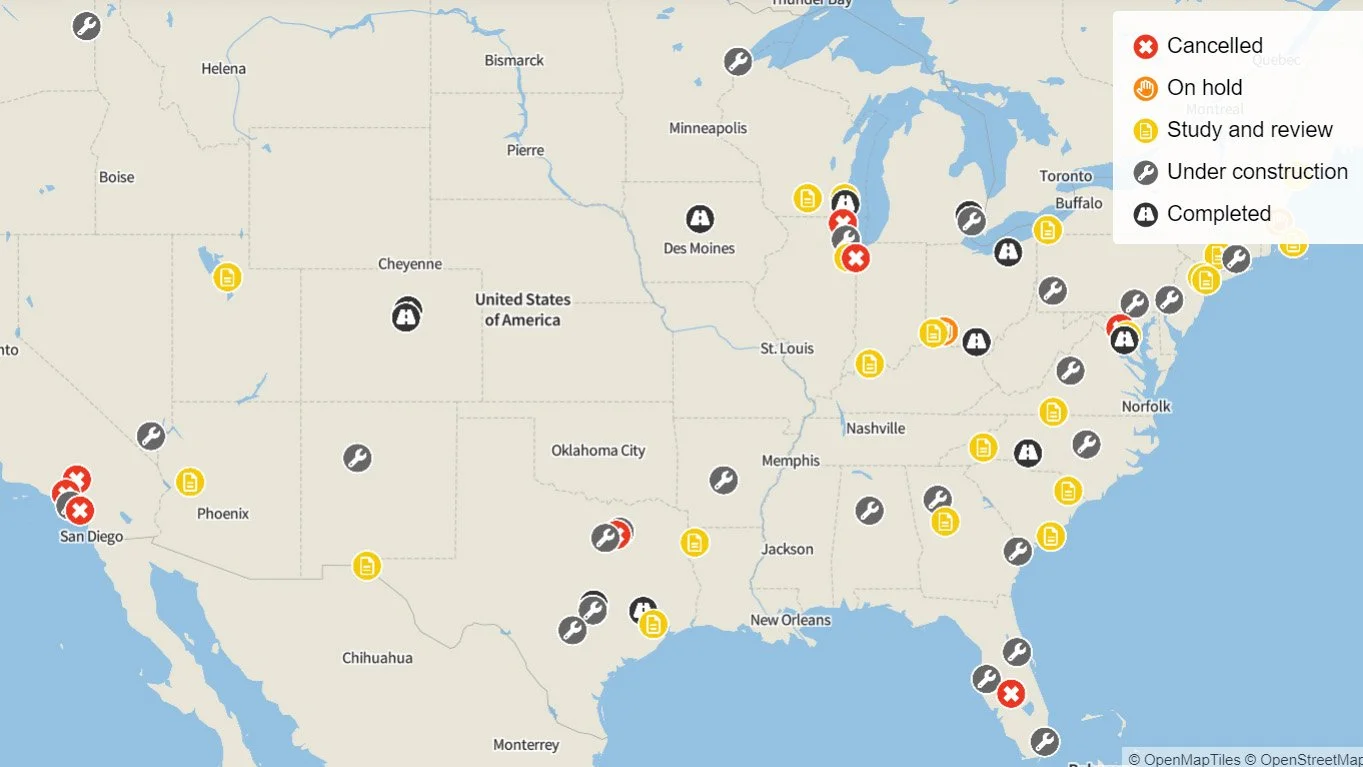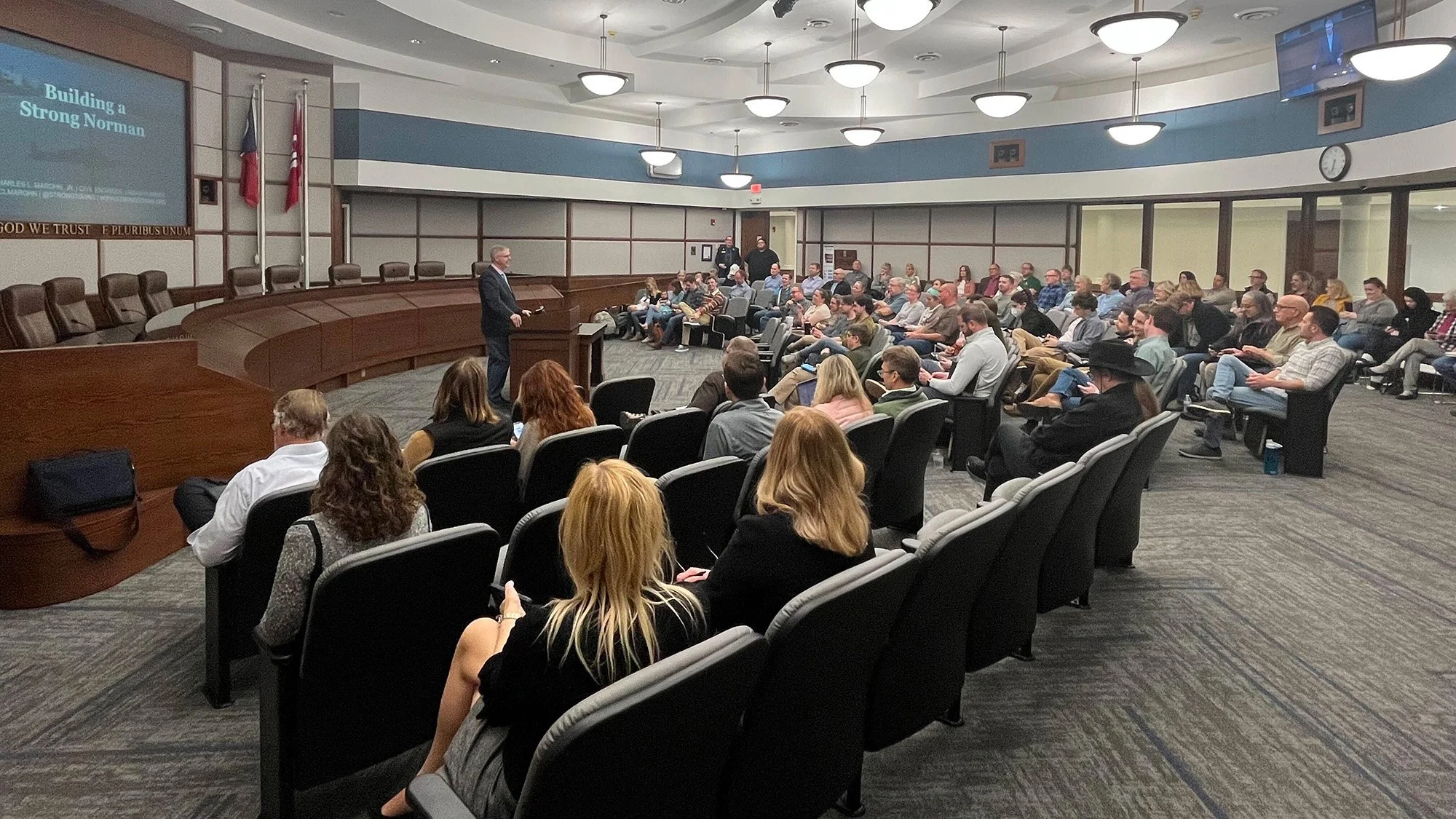3 of the Worst Highway Expansion Projects Singled Out by the Highway Boondoggles Report
A map showing highway boondoggles across the U.S. (Source: PIRG.)
In November 2021, the Biden administration signed the $1.2 trillion bipartisan infrastructure bill into law, nearly doubling the funding available for transportation projects across the United States. To many, the law’s programs—among them Reconnecting Communities—symbolized an auspicious reversal of values that have characterized the past 70 years of transportation planning. Dressed in the language of reconciliation, the law seemingly offered an opportunity to not only reimagine how transportation is built and maintained, but fund this new future.
Yet, the latest Highway Boondoggles Report showcases how much of that money risks doubling down on the historic harms the law intended to redress.
The Report spotlights seven highway expansion and construction projects that gained momentum and capital through the law. From Washington to Massachusetts, these seven projects are slated to cost more than $15.9 billion, discretionary money that could’ve and even should’ve been earmarked for “real and critical needs in our transportation system.”
Below are three of the boondoggles singled out by the Report:
1. Interstate Bridge Replacement, Oregon and Washington. Cost: $5–7.5 billion.
Of the seven projects in the report, the Interstate Bridge Replacement (IBR) comes with the highest price tag and arguably, the most deceptive marketing. What both the Washington and Oregon Departments of Transportation are jointly proposing is not simply a bridge replacement, “but rather a major freeway expansion that would almost double the size of the existing bridge while also rebuilding several freeway interchanges in the city of Vancouver and the city of Portland.”
The devil is in the details. Project documents outline an expansion of one lane in each direction—bringing the bridge from six to eight total—through the use of auxiliary lanes. Yet, the widths of those lanes stretch up to 164 feet, which the authors note is wide enough for 12 lanes of traffic, “should ODOT and WSDOT decide to restripe it in the future.”
Historically, more lanes compound the problems they claim to solve, and the IBR is no exception. Furthermore, there’s mounting evidence that WSDOT’s traffic projections are flawed, in the first place. Several studies conclude that the agency overestimated traffic volumes by tens of thousands of vehicles per day. These were figures submitted to justify the project’s scope and budget.
As for the budget itself, Joe Cortright of City Observatory noted that ODOT has a record of overrunning already inflated costs in a piece scrutinizing the IBR. “The price tag for the project jumped 54 percent in December, 2022,” he wrote. Now it’s estimated at $7.5 billion with much of that increase unaccounted for.
In the end, the IBR is, by many accounts, an over-engineered and expensive solution looking for a problem. While fortifying connections between Oregon and Washington are neither new nor totally unnecessary, a highway expansion of this scale isn’t meaningfully addressing connectivity. In fact, it will probably worsen congestion.
2. The Mid-States Corridor, Indiana. Cost: $735 million–$1 billion.
The Mid-States Corridor is a proposed 54-mile highway that slices through rural Southern Indiana and mirrors the nearby Interstate 69. In some ways, the Corridor is a “zombie project,” having surfaced in some form or another for decades. According to the Report, its predecessor was shelved in 2014 on the basis that “such a road was no longer warranted.” However, the project’s proponents have kept the idea of a highway parallel to I-69 alive until it took its current form as the Mid-States Corridor.
Like nearly all highway construction and expansion projects, the Mid-States Corridor promises to alleviate congestion and speed up travel for both commuters and consumer goods. In fact, anticipating and managing growth has been a central justification for the project. Yet, opponents are raising questions about Indiana Department of Transportation’s (INDOT’s) math.
In a 2020 letter to INDOT, a coalition of local groups wrote:
In justifying other highway projects, INDOT has argued that significant population growth is what justifies highway construction in undeveloped areas – on the basis that more people means greater demand for highway infrastructure.
Here, INDOT tries to claim the opposite – that low population growth should be addressed by building a new highway.
INDOT cannot have it both ways. It is nonsensical to claim that when an area is growing, the state should build a highway to accommodate this growth, and also that when an area is declining, the state should build a highway to create growth. By this logic, Indiana should be building highways literally everywhere.
3. The Brooklyn-Queens Expressway, New York. Cost: $1.5–4 billion.
For years, New York City residents and city officials have been divided over whether to rehabilitate the often traffic-choked Brooklyn-Queens Expressway (BQE) or dismember it entirely, but everyone could agree that addressing the crumbling conduit's fate is urgent. In March 2023, it appeared the city and state finally landed on a plan. To the surprise of many Brooklynites, that plan involves expanding the BQE.
One of the options being weighed for the triple-cantilever section of the expressway keeps the roadway at two lanes while the other expands it to three. What the Highway Boondoggles Report reveals is that both result in a wider road than what exists today.
With the BQE supporting up to 130,000 vehicles daily—10%, or 13,000 of them being trucks—repairing the structural deficiencies is not what’s being debated. Instead, opponents are asking whether it’s possible to address the immediate safety concerns in the short term without erecting more concrete in the long term.
As the Report put it: “New York City transportation authorities are set to squander a once-in-a-generation opportunity to reimagine a polluting and outdated highway, instead pursuing [federal] dollars to fast-track a misguided expansion project.”
Building new roads diverts billions of taxpayer dollars from repairing existing ones. More than 162,000 miles of major U.S. highways are in “poor or mediocre” condition, many of which require “substantive” repairs, according to the Highway Boondoggles Report.
Before we can fix the crumbling roads we currently depend on, we have to stop making the problem worse. That’s why ending highway expansion is a priority for Strong Towns. Join us in the fight by learning freeway-fighting tactics from the advocates who are on the ground pushing back against harmful highways in their communities.






Asia (pronounced “ah-sha”) Mieleszko serves as a Staff Writer for Strong Towns. A dilettante urbanist since adolescence, she's excited to convert a lifetime of ad-hoc volunteerism into a career. Her unconventional background includes directing a Ukrainian folk choir, pioneering synaesthetic performances, photographing festivals, designing websites, teaching, and ghostwriting. She can be found wherever Wi-Fi is reliable, typically along Amtrak's Northeast Corridor.